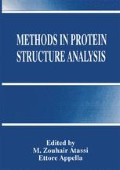Abstract
Traditionally, proteins have been regarded as well-defined, uniform molecules, where one molecule is virtually identical to the next. This notion has been supported by the fact that the highly efficient protein primary structure analysis by prediction from the DNA sequence will result in a well-defined, unique amino acid sequence, containing no direct indication of any kind of modification or processing. However, information is accumulating about protein heterogeneity, co- or post-translational modification and processing as well as about the functional implications of the structural variation (Krishna and Wold, 1993; Graves et al., 1994). Human fibrinogen may serve as an extreme example of a protein existing in a multitude of structural forms, many of which have been demonstrated to differ in functional properties (Henschen and McDonagh, 1986; Henschen, 1993). In the following, the various, so far recognized structural variations and their possible function effects, together with some relevant identification procedures will be described.
Access this chapter
Tax calculation will be finalised at checkout
Purchases are for personal use only
Preview
Unable to display preview. Download preview PDF.
References
Baumann, R.E., and Henschen, A.H., 1993, Human fibrinogen polymorphic site analysis by restriction endonuclease digestion and allele-specific polymerase chain reaction amplification: Identification of polymorphisms at positions Aa312 and Bß448, Blood, 82: 2117–2124.
Baumann, R.E., and Henschen, A.H., 1994, Linkage disequilibrium relationships among four polymorphisms within the human fibrinogen gene cluster, Human Genetics, 94: 165–170.
Blombäck, B., Blombäck, M., Edman, P., and Hessel, B., 1966, Human fibrinopeptides. Isolation, characterization, and structure, Biochim. Biophys. Acta, 115: 371–396.
Blombäck, B., Gröndahl, N. J., Hessel, B. Iwanaga, S., and Wallén, P., 1973, Primary structure of human fibrinogen and fibrin. II. Structural studies on NH2-terminal part of y chain, J. Biol. Chem., 248: 5806–5820.
Chen, N. and Henschen, A., 1994, Identification of methionine sulfoxide in native and oxidized fibrinogen, Protein Sci. 3, Suppl. 1: 147.
Chung, D.W., and Davie, E.W., 1984, y and y’ chains of human fibrinogen are produced by alternative mRNA processing, Biochemistry 23: 4232–4236.
Chung, D.W., Harris, J.E., and Davie, E.W., 1990, Nucleotide sequences of the three genes coding for human fibrinogen. In: Fibrinogen, thrombosis, coagulation and fibrinolysis. ( Liu, C.Y., and Chien, S. eds.) Plenum, New York, pp. 39–48.
Ebert, R.F., 1991, Index of variant human fibrinogens, CRC Press, Boca Raton.
Farrell, D. H., Mulvihill, E.R., Huang, S., Chung, D.W., and Davie, E.W., 1991, Recombinant human fibrinogen and sulfation of the y’ chain, Biochemistry, 30: 9414–9420.
Fornace, A.J., Cummings, D.E., Comeau, C.M., Kant, J.A., and Crabtree, G.R., 1984, Structure of the human y-fibrinogen gene. Alternate mRNA splicing near the 3’ end of the gene produces yA and 7B forms of y-fibrinogen, J. Biol. Chem. 259: 12826–12830.
Fu, Y., and Grieninger, G., 1994, Fib 420: a normal human variant of fibrinogen with two extended a chains, Proc. Natl. Acad. Sci. USA 91: 2625–2628.
Graves, D. J., Martin, B.L., and Wang, J. H., 1994, Co-and post-translational modification of proteins. Chemical Principles and biological effects. Oxford University, New York. pp. 1–348.
Henschen, A., and Edman, P., 1972, Large scale preparation of S-carboxymethylated chains of human fibrin and fibrinogen and the occurrence of 7-chain variants, Biochim. Biophys. Acta 263: 351–367.
Henschen, A., and McDonagh, J., 1986, Fibrinogen, fibrin and factor XIII. In: Blood coagulation. ( Zwaal, R.F.A., and Hemker H.C. eds.) Elsevier, Amsterdam. pp. 171–241.
Henschen, A.H., 1993, Human fibrinogen - structural variants and functional sites, Thromb. Haem. 70:42–47. Henschen, A.H., 1993, Identification of tyrosine sulfate and tyrosine phosphate residues during sequence analysis, Protein Sci., 2, Suppl. 1: 152.
Henschen, A.H., 1994, Human fibrinogen occurs as over 1 million nonidentical molecules, J. Protein Chem., 13: 504–505.
Henschen, A.H., Theodor, I., and Pirkle, H., 1991, Hydroxyproline, a posttranslational modification of proline, is a constitutent of human fibrinogen, Thromb. Haem. 65: 821.
Humphries, S.E., Cook, M., Dubowitz, M., Stirling, Y., and Meade, T.W., 1987, Role of genetic variation at the fibrinogen locus in determination of plasma fibrinogen concentrations, Lancet. 1452–1455.
Kannel, W.B., D’Agostino, R.B., and Belanger, A.J., 1987, Fibrinogen, cigarette smoking, and risk of cardiovascular disease: Insights from the Framingham Study, Am. Heart J. 113: 1006–1010.
Krishna, R.G., and Wold, F., 1993, Post-translational modification of proteins, Adv. Enzymol. Related Areas of Mol. Biol. 67: 265–298.
Müller, E., and Henschen, A., 1988, Isolation and characterization of human plasma fibrinogen molecular-sizevariants by high-performance liquid chromatography and amino acid sequence analysis. In: Fibrinogen. ( Mosesson, M.W., Amrani, D.L., Siebenlist, K.R., and Diorio, J.P. eds.) Elsevier, Amsterdam, pp. 279–282.
Nakashima, A., Sasaki, S., Miyazaki, K., Miyata, T., and Iwanaga, S., 1992, Human fibrinogen heterogeneity: The COOH-terminal residues of defective Act chains of fibrinogen II, Blood Coag. Fibrinol. 3: 361–370.
Seydewitz, H.H., and Witt, I., 1985, Increased phosphorylation of human fibrinopeptide A under acute phase conditions, Thromb. Res. 40: 29–39.
Töpfer-Petersen, E., Lottspeich, F., and Henschen, A., 1976, Carbohydrate linkage site in the 0-chain of human fibrin, Hoppe-Seyler’s Z. Physiol Chem. 357: 1509–1513.
Author information
Authors and Affiliations
Editor information
Editors and Affiliations
Rights and permissions
Copyright information
© 1995 Springer Science+Business Media New York
About this chapter
Cite this chapter
Henschen-Edman, A.H. (1995). Human Fibrinogen Occurs as Over 1 Million Non-Identical Molecules. In: Atassi, M.Z., Appella, E. (eds) Methods in Protein Structure Analysis. Springer, Boston, MA. https://doi.org/10.1007/978-1-4899-1031-8_39
Download citation
DOI: https://doi.org/10.1007/978-1-4899-1031-8_39
Publisher Name: Springer, Boston, MA
Print ISBN: 978-1-4899-1033-2
Online ISBN: 978-1-4899-1031-8
eBook Packages: Springer Book Archive

